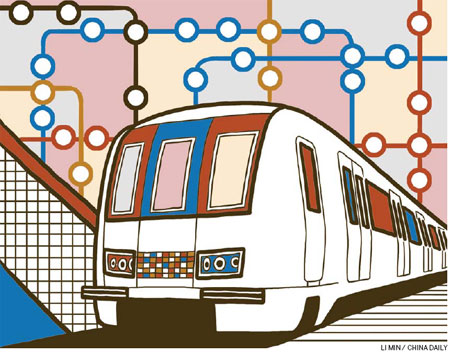The promise of tunnel vision
Updated: 2011-12-30 08:51
By He Chuan (China Daily)
|
||||||||

Wuhan, like many other cities in China, has a view of the future that is to some extent tunnel-visioned. The city of 9 million people in Central China has just published an ambitious plan: every year from 2012 to 2017 it will build a new subway line. At the end of 2017, the new subway system will stretch over 215 kilometers.
Ten Chinese cities now have a total of 31 subway lines, stretching more than 800 kilometers. Recently the State Council ratified municipal subway construction plans for 22 cities with an investment of more than 882 billion yuan ($139 billion, 106 billion euros).
Clearly, China has become the world's largest underground railway construction market. However, the subway boom in a developing country like China has raised questions at home and abroad, with critics questioning the necessity of building them in so many cities, with the heavy loads of local government debt that they bring.
While subway construction seems to have unstoppable momentum now, it does raise issues that ought to be carefully considered.
In the US, when the automobile industry was booming the construction of public transport focused on cars. Many years later governments worldwide agree that subways offer critical help in alleviating pressure on public transport.
Now in metropolises worldwide, the volume of subway transport accounts for more than 50 percent of public transport patronage. In some cities the rate exceeds 70 percent.
For example, Paris has a population of more than 10 million, and an annual traffic volume of 1.2 billion. Nearly 70 percent of those people use subways. In Tokyo, the rate can be as high as 86 percent.
And many cities with populations of less than 1 million, such as Boston, Ottawa, and Frankfurt, have vigorously expanded their subway systems.
So it can be seen that with the rapid growth of China's economy as well as the urban population, the country needs to expand subway construction in some cities that have the right conditions. Local governments need to carry on this project with a perspective that looks far into the future.
According to statistics, China's rate of urbanization rose from 30.5 percent to 46.6 percent between 1996 and 2008. The rate is expected to increase to 60 percent in 2020. China will then have 620 million people living in cities, among whom more than 480 million will live in metropolises that have more than 1 million inhabitants.
The total number of those in China living in cities is nearly double that of the total US population, and a quarter more than that of the European Union. The annual net growth of Chinese urban population ranks first in the world, as does the scale of urbanization.
Among the 655 cities in China, 23 have population exceeding 2 million, and 35 have population of between 1 million and 2 million. The sheer size of cities is pushing local governments to invest more on subway building to reduce transport pressure. So there is nothing less surprising than seeing many Chinese cities digging underground to provide solutions.
More and more Chinese are looking forward to having subways in their cities. Last year a study was made of people's preferences in public transport, and 60.6 percent of the surveyed hoped to build or expand subways in their cities, which, they said, are convenient, environmentally friendly and punctual.
As is the case elsewhere, subways in China are built to serve the public rather than to generate profit, and the underground railways are helping to push the process of urbanization, narrow the gap between urban and rural areas, and boost the development of local economies.
Subway construction has also helped deliver social development and environmental protection.
So subway projects should not simplistically be judged by the bottom line. As far as I know, most subways in the world lose money every year, the system in Hong Kong being one of the few exceptions.
So in talking about building subways the emphasis should be placed on improving the environment, whether that be to do with matters of space, traffic, ecological or social concern.
Wuhan is a typical Chinese metropolis whose layout is changing from "main city and scattered satellite towns" to "main city zone and newly developed areas".
In such an open city structure, only a complete subway system can effectively support the development of the main city area and the inter-connected newly developed areas.
There is no doubt that the huge subway project in Wuhan will boost the city's development. Subway traffic will account for more than 35 percent of public transport. As interchanging becomes more convenient, the importance of public transport will increase, and as the time to make long-distance trips is reduced traffic congestion will be eased. This in turn will help new city districts and key industries to develop.
In cities such as Shanghai, Chongqing and Chengdu, subway lines have halved commuting times and local residents can traverse main city zones in half an hour.
At the same time, the investment environment in Shanghai, Chongqing and Chengdu has improved markedly. For example, Chengdu, a city in Southwest China, is trying to build an international garden city, with one important step being to expand the subway. It is planned to have nine lines operating in 2020. Those lines will not only reduce the pressure on public traffic but connect the scattered towns with the beautiful scenery around Chengdu. Already, thanks to the subway, many small towns around the main city zone are in the "half-an-hour business zone" of Chengdu.
None of this is to say that a boom in subway building does not throw up problems. While a system does exist for examining and approving plans for subways in China some cities have fallen short of the mark in this regard. For some officials, ostentatious subway projects are even regarded as a badge of honor in flaunting their achievements. That can result in unrealistic schedules that pose risks to safety and to the environment.
Those problems notwithstanding, I believe there is no reason why Chinese subways cannot be developed in a timely way.
The author is a professor at Southwest Jiaotong University, in Chengdu of Sichuan province.











